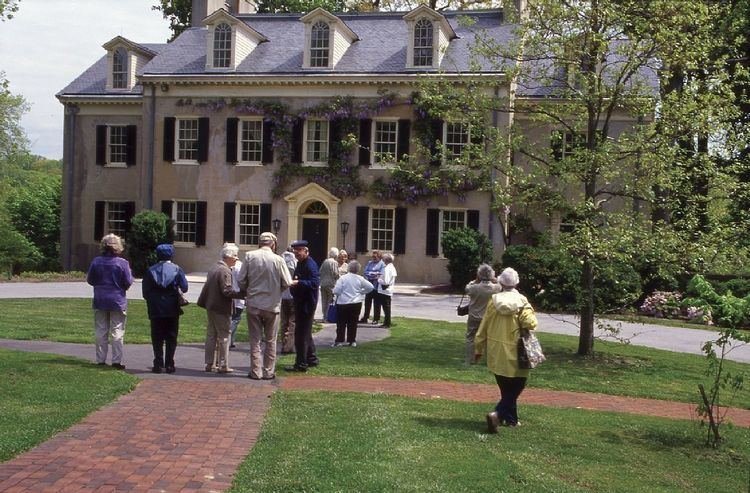NRHP Reference # 84000819 Area 95 ha Added to NRHP 13 November 1966 | Built beginning 1802 Opened 1803 Phone +1 302-658-2400 | |
 | ||
Address 200 Hagley Creek Rd, Wilmington, DE 19807, USA Hours Open today · 10AM–4PMTuesday10AM–4PMWednesday10AM–4PMThursday10AM–4PMFriday10AM–4PMSaturday10AM–4PMSunday10AM–4PMMonday10AM–4PM Similar Brandywine Creek, Winterthur Museum - Garden a, Nemours Mansion and Gard, Brandywine Zoo, Brandywine River Museum Profiles | ||
Hagley museum and library introduction video
The Hagley Museum and Library is a nonprofit educational institution in Wilmington, Delaware. Covering more than 235 acres (0.95 km²) along the banks of the Brandywine Creek, the museum and grounds include the first du Pont family home and garden in the United States, the powder yards, and a 19th-century machine shop. On the hillside below the mansion lies a Renaissance-revival garden, with terraces and statuary, created in the 1920s by Louise Evalina du Pont Crowninshield (1877–1958). The facility sits at the midpoint of the DuPont Historic Corridor.
Contents
- Hagley museum and library introduction video
- Visit hagley museum and library museum in wilmington delaware united states
- Operations
- History
- Origin of the name
- Chronology
- References
Visit hagley museum and library museum in wilmington delaware united states
Operations
Opened in 1957, the Hagley Museum features exhibits and demonstrations that show the connections between early industrial technology and early American history, focusing on the histories of the du Pont family, DuPont company, explosives and gunpowder, and innovation (through a large collection of American Patent models). The Museum also explores personal stories of the 19th-century DuPont Company employees, how they lived, and how their lifestyles changed along with new machinery and new production methods.
Hagley's library houses a major research collection of manuscripts, archives, photographs, pamphlets, and books documenting the history of American business and technology. A member of the Independent Research Libraries Association, the library serves scholars from this country and abroad. Holdings include 37,000 linear feet in the Manuscripts and Archives Department, 290,000 printed volumes in the Imprints Department, 2 million visual items in the Pictorial Department, and more than 300,000 digital images and pages in the Digital Archives Department. The library and archival collections owned by Hagley are open to the public for research; a catalog and partial digital archive are available online.
The library includes Hagley's intellectual heart: the Center for the History of Business, Technology, and Society, which coordinates Hagley's interactions with the world of scholarship in the fields of American economic, business, and technological history. The center offers a scholar-in-residence program and competitive fellowships, and organizes seminars and historical conferences.
History
In 1802, French immigrant Eleuthère Irénée du Pont founded black powder mills on the banks of Brandywine Creek. He chose the location for the river's tumble over the fall line which provided power, timber and willow trees (used to produce quality charcoal required for superior black powder), the proximity to the Delaware River (on which other ingredients of the powder – sulfur and saltpeter – could be shipped); and the quarries of gneiss which would provide building materials for the mills. The E. I. du Pont de Nemours & Company's black powder factory became the largest in the world.
In 1921, the mills along the Brandywine closed and parcels of the property were sold. Plans for a museum were established 31 years later, on the occasion of the DuPont Company's 150th anniversary in 1952.
Origin of the name
Hagley historians only know that the name was already in use well before E.I. du Pont expanded downstream from Eleutherian Mills in 1813 by purchasing the land that became the Hagley Yards. An 1813 document refers to the land as Hagley and it had been called Hagley as early as 1797, when its owner, Philadelphia Quaker merchant Rumford Dawes, applied for insurance on buildings that were said to be located in a place called Hagley on the Brandywine. Dawes had acquired the property in 1783. Since the name Hagley did not appear on the documents transferring ownership at that time, it seems likely that Dawes gave this name to the Brandywine location.
It seems likely that Delaware's Hagley was named for an English estate that was well known in the second half of the eighteenth century. It is likely that Dawes chose the name based on an English narrative poem entitled The Seasons by James Thomson. Hagley Hall was the seat of Thomson's patron the Baron Lyttelton, and the poem's description of a sylvan dale is strikingly reminiscent of the Brandywine Valley. The Seasons was popular in Philadelphia at the time that Rumford Dawes acquired and named Hagley. The English Hagley estate is located in the West Midlands countryside about ten miles southwest of Birmingham. Perhaps coincidently, Delaware's Hagley is about 8 miles south of Chadds Ford Township, officially known as Birmingham Township before 1996.
At about the same time, Hagley Plantation on the Waccamaw River in South Carolina got its name when the owners, who were admirers of English culture, chose the name Hagley to remind them of the well-known parkland of that name near London.
The Museum was featured on Mysteries at the Museum television show.
